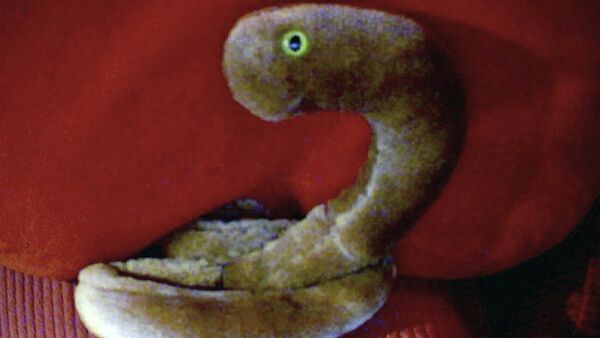MOSCOW, October 21 (RIA Novosti) - A US firm, Connecticut-based GIANTmicrobes, has recently sold out thousands of plush Ebola toys, which are touted as a “uniquely contagious gift” that can help a person learn “all about a fearsome front page disease.”
Resembling a curly brown worm with a cat’s eye, the plush Ebola toy is an exact replica of a microscopic image of the virus.
According to Laura Sullivan, the vice president of marketing and operations at GIANTmicrobes, the toy is in hot demand and the company is already out of stock worldwide.
But she promised that her company is “making it as fast as we can” and another batch is due next week.
“We actually get a tremendous amount of interest in the product as a teaching tool, and as a way to talk particularly to children about something that is otherwise a very abstract idea,” she told Radio VR. “If you give kids something to hold and look at, and read – it makes it a little bit less scary and a little bit more tangible for them. So, we've got a tremendous amount of feedback from parents, saying that it is helpful. And we have also sold a lot of them to individual US state departments of health, where they are used as training and teaching mechanisms.”
“So, we continue to have it used wherever it is possible, as an awareness-building and educational tool,” she added. “We are seeing orders from school systems, where they are buying them and then distributing them to individual schools in their system. We are getting orders from the departments of health within different states in the US. And we’ve talked to some of them; they are using them as training tools. But we also know that we are selling them to private individuals, who, I think, are using them at home to talk about it and understand it better, and are also just curious to learn more. Ebola isn’t something that most people know a lot about. You sort of know that it exists and it is a scary thing, but you don’t know too much about it.”
And when there is an outbreak like this, Laura Sullivan said, it is just a function of natural human curiosity to want to learn a little bit more.
Ms. Sullivan, however, doubts that a child who is familiar with their toys would be able to act differently from a child who has not had access to them, if he or she encounters an infected person, in a way that would prevent contagion. Nevertheless, she noted that the toy still remains a useful tool. As something tangible, it helps children understand the virus, as it is hard for them to comprehend abstract ideas.
Laura Sullivan said that GIANTmicrobes’ bestseller, in fact, is a large plush model of the Common Cold, which helps teachers demonstrate how children can protect themselves from catching colds in school by “learning to wash their hands more and things like that. It is more concrete, because it is in their world.”
“The product is being used is the same way, which is just to try to facilitate an understanding about something that is otherwise hard to understand. It is hard to understand invisible things and GIANTmicrobes is all about trying to bring the invisible world, the microscopic world, kind of to life for people,” she said.
The company has listed the World Health Organization (WHO) as one of its largest customers, along with pharmaceutical companies and the American Red Cross.
“We work with the WHO, the CDC (The US Centers for Disease and Prevention), the American Red Cross, a lot of pharmaceutical companies, research companies,” she said. “Not just [with] Ebola, of course, but, like I said, we've got over a hundred different microbes in the line. So, there is sort of a microbe for everyone out there. So, we work with a lot of these types of organizations to create materials that they then use for their own internal training and education purposes.”
Ms. Sullivan added that none of these organizations have ever complained about their toys; instead they applauded her company for making something that is educational.
“When you think about the ‘toys’ or products that are available for medical professionals and researchers, and for people who are involved with these serious topics, there isn’t anything that is sort of corky or fun, or whimsical, or different,” she said. “And I think what GIANTmicrobes is providing is an alternative way to break the ice about conversations, talks about things, and learn about things that are not your typical textbook material. We’ve been applauded for providing an alternative to everything else that is out there.”

